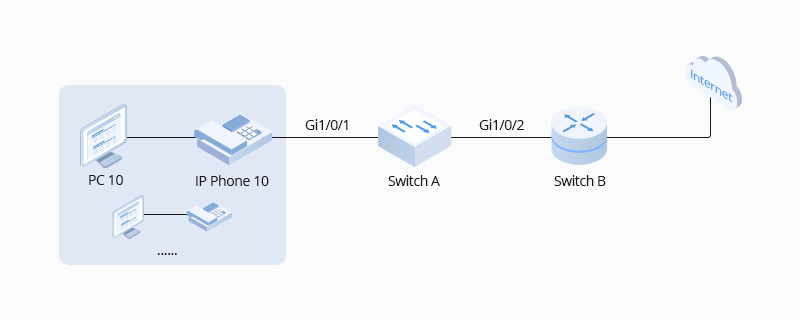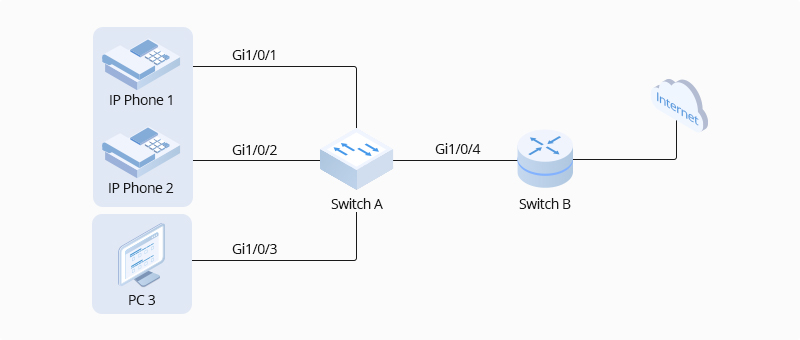Auto VoIP vs Voice VLAN: What's the Difference?
Auto VoIP and Voice VLAN are two functions of the switch, both of them can handle voice traffic and improve voice quality. Auto VoIP vs Voice VLAN: the working principles, benefits, and differences are illustrated in this blog.
What Is IP Phone
An IP phone also called a VoIP phone, is a phone that uses internet protocol. An IP phone connects through an Ethernet cable to the internet, where it connects to the IP address of either the VoIP provider or the hosted PBX provider. IP telephony offers HD voice quality, cheaper running costs, and advanced business phone features. With the development of network technology, the application of IP Phones has become more extensive and popular, especially for businesses.
What Is Auto VoIP?
VoIP is an acronym for Voice over Internet Protocol and describes the method of making and receiving phone calls over the Internet. It's a cost-effective way to handle an unlimited number of calls and to ensure high voice quality. The Auto VoIP feature of the network switch is used to prioritize the delivery of voice traffic. Voice traffic is typically more time-sensitive than data traffic, and voice quality can deteriorate significantly due to packet loss and delays. With the Auto VoIP feature, voice traffic can be prioritized.
How Does Auto VoIP Work?
The Auto-VoIP feature copies VoIP signaling packets to the CPU to get the source and destination IP address and Layer 4 port of the current session. Based on these parameters a filter is installed to assign the highest priority to VoIP data packets. As soon as the call ends, the filters are removed.
As shown below, the company plans to install IP phones in the office area. IP phones share switch ports used by computers, because no more ports are available for IP phones. To ensure good voice quality, voice traffic requires a higher priority than data traffic. To optimize voice traffic, you can configure Auto VoIP and LLDP-MED to instruct IP Phones to send traffic with desired DSCP priority. Voice traffic is put in the desired queue and data traffic is put in other queues according to the Class of Service configurations. Make sure that the voice traffic can take precedence when congestion occurs.

Benefits of Auto VoIP
-
Auto-VoIP automatically makes sure that time-sensitive voice traffic is given priority over data traffic on ports that have this feature enabled.
-
Auto-VoIP checks for packets carrying the VoIP protocols, VoIP frames that are received on ports that have the Auto-VoIP feature enabled are assigned to queue.
-
Auto VoIP provides flexible solutions for optimizing voice traffic. It can work with other features such as VLAN and Class of Service to process the voice packets with specific fields.
What is Voice VLAN
A voice VLAN is a VLAN ( virtual local area network) that is specifically allocated for users' voice data streams. It ensures the quality of voice traffic by improving the transmission priority when transmitted with other traffic. That is to say, when other services (data, video, etc.) are transmitted simultaneously, voice service will be prioritized and transmitted with a higher forwarding priority.
How Does Voice VLAN Work
To increase the priority of voice data streams, you must first identify them. Voice VLAN can identify voice data streams in two modes: In the MAC address-based mode, a network switch can determine whether the data stream is a voice data stream according to a source MAC address field in a data packet that enters its interface.
In the VLAN-based mode, a network switch determines whether the data packet is a voice packet based on the VLAN ID of the packet entering the interface. Voice VLAN is generally used in scenarios where IP phones exist such as big enterprises and financial industries. In these places, offices are widely distributed and the staff is scattered, increasing the need for IP phones to maintain frequent multi-party communication. When there is no need to connect a PC for data services, voice VLAN is typically used in conference rooms.
As shown below, the company plans to install IP phones in the office area. To ensure good voice quality, IP phones and computers will be connected to the different ports of the switch, and the voice traffic requires a higher priority than the data traffic. To achieve this requirement, you can configure Voice VLAN to ensure that the voice traffic can be transmitted in the same VLAN and the data traffic is transmitted in another VLAN. In addition, specify the priority to make the voice traffic take precedence when congestion occurs.

Benefits of Voice VLAN
-
It ensures that your VoIP (Voice over Internet Phone) devices do not have to contend directly with all the broadcasts and other traffic from the data VLAN.
-
A voice VLAN can simplify network configuration in some circumstances. It is much easier to mark packets for QoS than specify various ranges of TCP and UDP ports. Similarly, TFTP and the special DHCP services for VoIP phones are easier to configure when all VoIP phones are in the same subnet.
-
It can be used to prioritize different voice services since it supports 802.1p Class of Service (CoS) priority or DSCP (Differentiated Services Code Point) priority.
Auto VOIP vs Voice VLAN: What's the Difference?
Voice VLAN and Auto VoIP both can handle voice traffic, but auto VoIP can distinguish the types of voice traffic in more detail and process them. Below are their main differences.
Creating Voice VLAN
When doing settings for the Voice VLAN application topology, we only need to create a voice VLAN ID and choose the uplink port in VLAN feature. There is no need to add ports that are connected to IP phones when creating VLAN. Unlike the Voice VLAN, Auto VoIP needs to add the ports that are connected to the IP phone to the target VLAN and set the port’s Egress rule when creating VLAN in VLAN feature.
OUI Information Setting
When packets reach the port which is enabled Voice VLAN, the switch will detect if the traffic is voice traffic according to its OUI information. But the Auto VoIP feature doesn’t need to set OUI information of the IP Phones because it doesn’t identify the voice traffic by reading its OUI information.
Priority for Voice Traffic Setting
Usually, when setting Voice VLAN/Auto VoIP, we’ll set priority information for the voice traffic to ensure it can be transmitted preferentially if there exists congestion. Voice VLAN can only set 802.1p priority for the traffic while Auto VoIP can support setting 802.1p priority and DSCP both.
LLDP-MED Configuration
The voice information configured on the Auto VoIP is sent to the IP Phones by LLDP communication between the switch and IP Phones. Only the LLDP communication is successful, the traffic from the IP phones will take the correct tag and the voice traffic will be transmitted successfully. So it needs to configure the LLDP-MED feature at the same time.
Conclusion
In summary, the purpose of these two functions is to isolate the voice traffic and other data traffic, and then mark the QoS tag for the voice traffic. These two features can be enabled on the ports that transmit voice traffic only or transmit both voice traffic and data traffic. Switches with these two functions can maintain the stability of the network and ensure smooth and delay-free conversations during important meetings.
You might be interested in
Email Address

-
PoE vs PoE+ vs PoE++ Switch: How to Choose?
Mar 16, 2023














